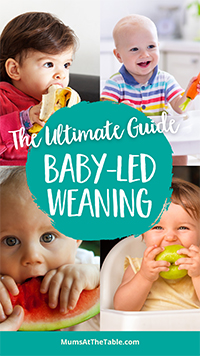Not sure where to start when it comes to baby-led weaning? We give you the low-down on what to do as you start introducing solids to bub.
So your baby is four (or six) months old and it’s time to start offering solids. Where do you even begin? As you ponder and research this, you would no doubt have come across baby-led weaning.
We’re here to explain just what baby-led weaning is, why you might like to try it with your child, and the pros and cons surrounding it.
What is baby-led weaning?
Baby-led weaning, or BLW, is really just fancy terminology for a very common process. It basically means . . . let the baby feed themself. It’s a feeding approach that allows infants to feed themselves food (other than milk) right from the start of the introduction of solid foods.
The food is offered in thicker pieces, often bigger than their little hand, so they can grasp it—and also so that it’s not a choking hazard. The food is easily squishable and soft, making for an easy meal with not too much chewing.
Lots of parents love baby-led weaning as it allows for a much simpler workflow in the kitchen when it comes to meal prep time. It also cuts out the costs of buying expensive baby food. In most cases, you can modify foods you’re already making for family meals to share with your baby.
When do I let my baby feed themself?
Teeth are a sign that it’s not only a good idea to introduce food but necessary. This usually happens by the time baby is six months old. Just look into your baby’s mouth to see if a tooth has popped through. The natural tongue-pushing reflex that babies are born with also disappears around 4–6 months of age. This means their tongue will not be automatically pushing food out of their mouth.
At the same time, your baby should be able to hold their head up, have neck control, sit upright in a high chair and have an interest in foods. An infant must also have doubled their birth weight at least before the introduction of solid foods.
At the age of six months, your baby will still be having milk feeds (either breastmilk or formula) in large quantities. However, this is the time their nutritional requirements for iron and zinc increase. As they cannot get this just from milk alone, it’s food time.
Introducing solid foods to your infant is a huge step for their nutrition, but also for their overall health. The eating patterns that children are raised on often tend to stay with them throughout their lives. Therefore, it is vital that children meet their nutritional requirements from a young age, consume healthy foods that will promote their overall wellbeing and develop a good relationship with food.
The baby-led feeding method allows a baby to have some independence and control over what goes into their mouths, which sets a good precedent for letting them eat intuitively from the start.
What do I feed my baby?
Traditional weaning looks like mushy food, spoon-feeding and oftentimes resistance. You can now forget purees and weaning spoons: This is a hands-on approach. Literally.
A baby’s food needs to be safe and age-appropriate. As the baby-led weaning approach is all about soft, thick food pieces that the baby can hold and put into their mouth, the food needs to be of a certain type and texture. Mashed potatoes, peas and carrots are off the menu, but you can cook a potato or carrot until they are soft and cut them into large chip shapes.
Food cut into too-small pieces is not safe for the child due to the choking risk and they are also unable to grasp it. Think large pieces of soft foods.
In the video below, nutritionist Amanda Muhl explains how to get started with BLW, what foods to begin with and how to make sure your baby is safe and happy during this process.
Some examples of the best baby-led weaning foods are:
- a large chunk of banana
- a thick piece of cooked sweet potato or potato
- a thick piece of peach/nectarine
- a thick finger-size piece of tofu
- a large slice of avocado
- a steamed floret of broccoli or cauliflower
- a thick slice of fritter
- a thick finger-size piece of bread with mashed avocado
The solids should generally look like finger foods made up of fruit and vegetables, and cover a variety of different foods with different textures.
It is best to avoid the following foods until after the age of one:
- dairy products especially cow’s milk (due to food allergies and gastrointestinal illness)
- foods with added sugars and no-calorie sweeteners
- high-sodium foods
- honey
- unpasteurised yoghurt or cheese
- raw carrots, grapes and popcorn due to choking hazard
- juices
- nuts (due to them being one of the typical allergenic foods)
Pros of baby-led weaning
Baby-led weaning has some great benefits for both the baby and the parents. Family foods can now largely be shared with the baby, allowing for a wide range of new foods to try. This also decreases cooking time and costs on the parents, making family meal time a lot easier.
The baby-led approach allows the opportunity for the development of fine motor skills and sensory exploration from the wide variety of tastes, colours, smells and textures.
Babies will still have the gag reflex by the time solid food is introduced. A gag reflex is different to choking and is simply caused by food touching the back of a baby’s mouth or throat. Choking, on the other hand, is when a baby’s airways get partially or fully blocked making it difficult for them to breathe sufficiently. If you notice your baby occasionally gagging when you introduce solid foods, it may simply be because they haven’t felt such sensations before.
By nine months of age, a baby should have developed the pincer grasp, meaning they will be able to more accurately pick up and hold items using their thumb, index and middle finger. This ability helps immensely for accuracy in picking up food items and successful self-feeding. It may also decrease the worry and frustration of food always going on the floor—but don’t let them feed themselves on the carpet anyway, just in case.
Cons of baby-led weaning
The downsides of this weaning style are mainly due to the amount of food that the baby intakes. As the baby is in charge of coordinating the food from the plate to their mouth, the amount they successfully get into their mouth and the amount they drop on the floor can vary. As a result, it can be hard to accurately measure how much food they’re eating and if they are meeting their requirements.
Another downside is that babies’ food preferences may be directed at a particular food group. They may learn to avoid the ones they don’t like and develop picky eating, which may again lead to their nutritional needs not being met.
It’s up to you
Overall, if you can safely monitor the amount of food your baby is consuming, then the weaning period following the baby-led approach can be a very helpful and efficient time for the entire family. It is always important to consult your child’s paediatrician when making nutritional choices for your child.
Also read: Weaning your baby from breastfeeding

How helpful was this article?
Click on a star to rate it!
0 / 5. 0
Be the first to rate this post!
Adriana Wales
Related posts
Subscribe
Receive personalised articles from experts and wellness inspiration weekly!

